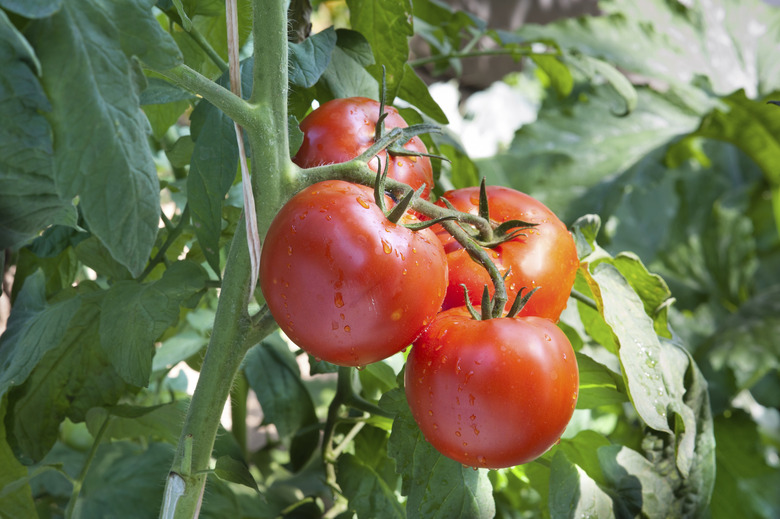Names Of Different Tomato Plants
If you're thinking about growing tomatoes (*Lycopersicon esculentum*) or you've already grown a few plants, then you might find learning about the several hundred available varieties a bit overwhelming. Before deciding what types to plant, take a look at the different groups of tomatoes and their special features. Then decide which ones best suit your climate, your planned use for the tomato fruits and your own taste preference.
Step 1
Many modern tomato varieties are hybrids, developed by crossing several types to produce plants that grow dependably, resisting diseases and producing a heavy crop. Like all tomatoes, they're frost-tender and grow as annuals in all parts of the United States. So they're best planted in a garden after all danger of frost has passed and nighttime temperatures stay above 45 degrees Fahrenheit. Hybrid tomato plants include the cultivar **"Big Boy,"** a plant that continues growing and producing young fruits all season. That kind of plant is called indeterminate. "Big Boy" produces red fruits that each weigh about 1 pound and begin ripening about 78 days after planting. **"Steakhouse"** is another example of a hybrid tomato that belongs to a type called beefsteak, named for the fruits' large size. "Steakhouse" fruits can weigh up to 3 pounds each. Often used sliced, the fruits begin ripening 75 to 80 days after planting. "Steakhouse" is an indeterminate plant.
Step 2
- Many modern tomato varieties are hybrids, developed by crossing several types to produce plants that grow dependably, resisting diseases and producing a heavy crop.
- So they're best planted in a garden after all danger of frost has passed and nighttime temperatures stay above 45 degrees Fahrenheit.
- Hybrid tomato plants include the cultivar **"Big Boy,"** a plant that continues growing and producing young fruits all season.
Heirloom Selections
Step 1
Older tomato varieties that have been handed down for generations are called heirlooms and often produce extra-flavorful or unusually colored fruits. A variety called **"Persimmon"** is an example of an heirloom plant; it produces yellow-to-orange, beefsteak-type fruits in about 80 days. Usually sweeter and less acidic than red tomatoes, its fruits weigh about 1 pound each. **"Green Zebra"** is another heirloom, and it was named for its green-and-yellow-striped fruits. Especially **high-yielding,** this variety produces small, 2- to 4-ounce fruits in about 78 days. Both varieties are indeterminate. Some tomato plants are called determinate because they produce all their fruits by mid-season then stop growing, making them choices for cool areas with a short growing season. The heirloom variety called **"Roma"** is that type, producing 2-ounce, oval fruits — sometimes called plum tomatoes — in about 70 days.
Step 2
- Older tomato varieties that have been handed down for generations are called heirlooms and often produce extra-flavorful or unusually colored fruits.
- A variety called **"Persimmon"** is an example of an heirloom plant; it produces yellow-to-orange, beefsteak-type fruits in about 80 days.
Varieties for Hot Climates
Step 1
All tomato plants grow best in full sun and can handle short periods of extreme heat. If, however, daytime temperatures stay above 85 F and nighttime temperatures remain at or above 72 F for more than one week, then tomato plants may not set fruit. If extra-hot summers are common where you live, choose a tomato variety bred to tolerate extreme heat. Examples of heat-tolerant tomato plants include an heirloom called **"Arkansas Traveler,"** an indeterminate plant that produces tartly sweet, 6- to 8-ounce red fruits in 75 days. **"Florida 91"** is a hybrid, disease-resistant plant that also thrives in hot weather. It is a determinate plant that produces 9- to 11-ounce fruits in 65 to 70 days. These plants also tolerate heavy rain, and their fruits don't tend to split — a problem called cracking — in hot weather.
Step 2
- All tomato plants grow best in full sun and can handle short periods of extreme heat.
- These plants also tolerate heavy rain, and their fruits don't tend to split — a problem called cracking — in hot weather.
Special Features
Step 1
Some tomato plants have special features that make them interesting or especially useful in a home garden. The variety called **"Early Girl"** is one example; it gets its name from its fast production of ripe fruits, in as little as 54 days. A disease-resistant hybrid, it is indeterminate and produces fruits all season. A few varieties have fruits that aren't typical colors. **"White Wonder"** has creamy-white, 8-ounce fruits in 85 days while **"Brandywine"** is an heirloom with pink-to-rose, extra-sweet, 12-ounce fruits that ripen in 80 days. A variety called **"Yellow Stuffer"** was named for its semi-hollow, lobed, lemon-yellow fruits that are shaped more like peppers than other tomato fruits. Ready to pick in about 80 days, its fruits can be stuffed with various ingredients. All of these plants are indeterminate.
Step 2
- Some tomato plants have special features that make them interesting or especially useful in a home garden.
- A variety called **"Yellow Stuffer"** was named for its semi-hollow, lobed, lemon-yellow fruits that are shaped more like peppers than other tomato fruits.
